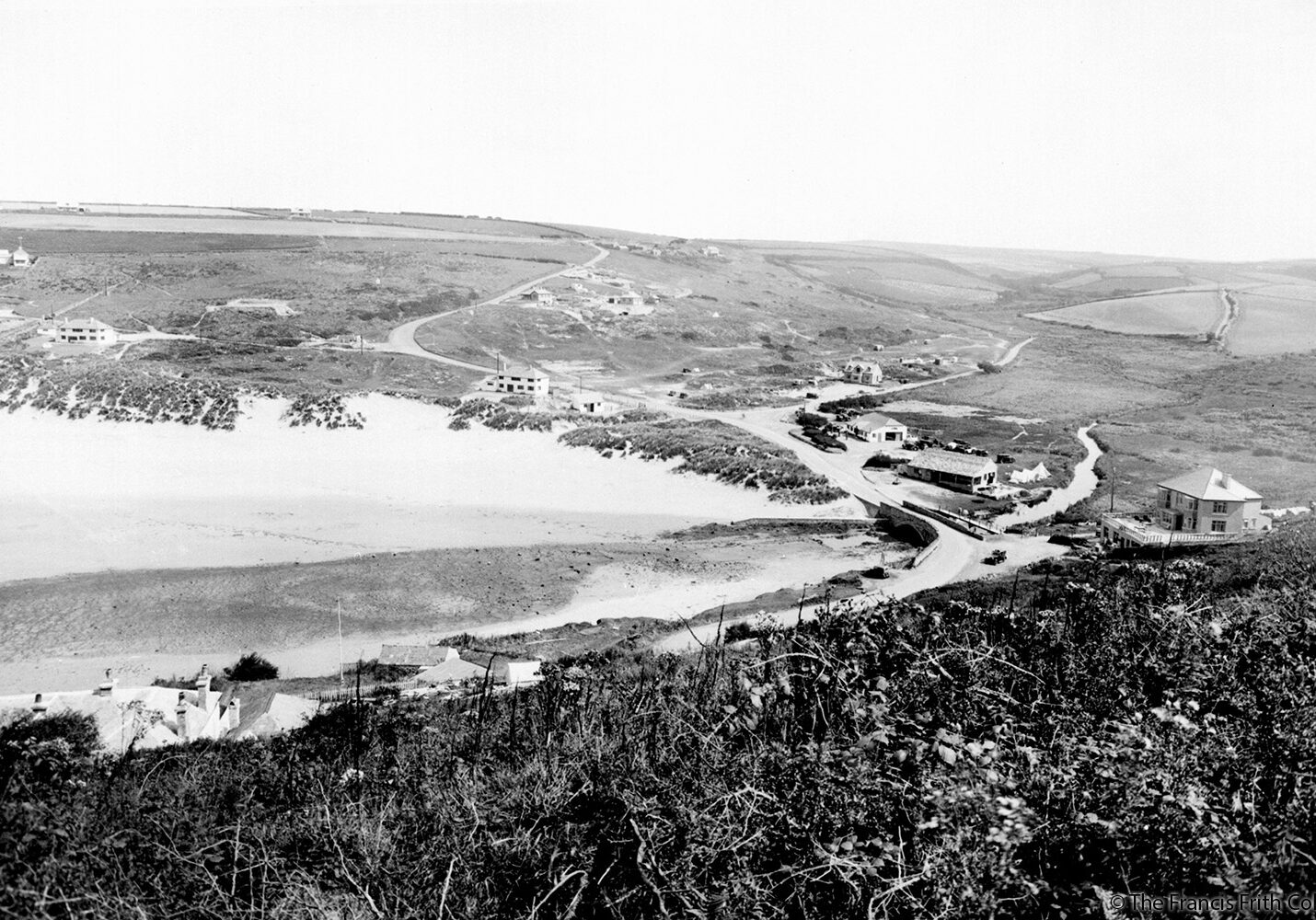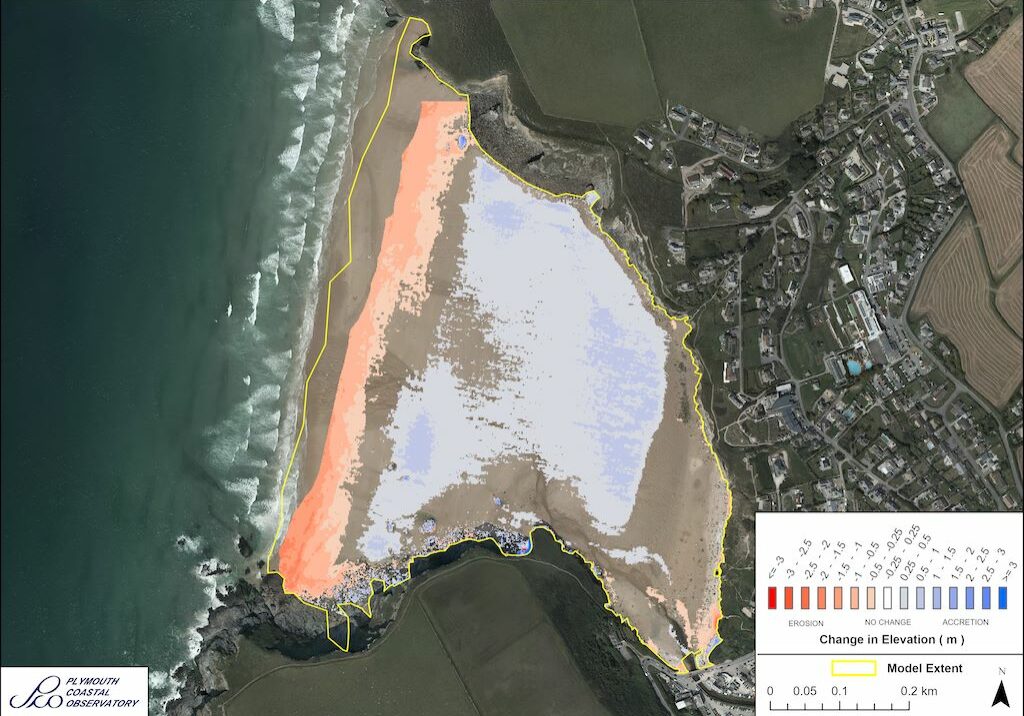
Mawgan Porth (Cornish: ‘Porth-Gluwyan’, meaning ‘Cove of St Mawgan’) is a west facing beach in north Cornwall. The beach is located at the mouth of the River Menalhyl, which meanders along the southern edge of the beach. The River Menalhyl has many tributaries and flows down the steeps sided wooded valleys of the Vale of Lanherne, which extends several kilometres east of St Columb Major.
Mawgan Porth is a wide embayed beach fringed by the imposing tall and steep cliffs of Berryl’s Point to the south and Trenance Point to the north. The area of usable beach is limited during high tide, but as the tide drops the retreating waters expose a broad area of flat golden sand.
The sand associated with Mawgan Porth rolls back into the remanent of what was a much larger dune system, upon which the village of Mawgan Porth has developed. Almost the entire length of this dune has been reinforced with a boulder barrier, which in some places, disconnects the dunes from the beach. The natural coastal defensive capacity of the dunes will, in the future, play an important function in protecting the community behind it, but some areas may still require a more engineered response.


Coastal Change
The coastline of Cornwall is an ever-changing environment. It is energetic, dynamic, never still and changes with each wave and each tidal cycle. Some of the changes we see are gradual and barely noticeable, whilst others, such as rockfalls, happen suddenly and often shockingly.
From one visit to the next it can sometimes be difficult to see how a beach and dune system has changed, but information has been collected, and is being collected through the Making Space for Sand project, to help us better understand how the coastline is changing. The purpose of this section of the website is to understand each location has changed over time, how it could change in the future and understand the policies that influence how we can respond to these changes.
Shoreline Management Plans (SMP)
The Shoreline Management Plan (SMP) is a strategic planning and management assessment tool that helps identify and measure the risk associated coastal erosion and coastal flooding. The document makes a number of policy recommendations over short, medium and long term timeframes setting out a strategic approach to managing the built, natural and historic environments associated with the coastline. Within SMP there are four policy approaches which have been assigned to stretches of coastlines. The four policies are: No Active Intervention (NAI), Hold the Line (HTL), Managed realignment (MR), and Advance the line (ATL).
Mawgan Porth sits within Policy Development Zone 13 (PDZ13), in Management Area 33 (MA33), within Policy Units (PU) 33.1, 33.3 and 33.4. The policy recommendations for these policy units are detailed in the table below and the SMP can be accessed through the Cornwall Council website.
Use your touchscreen
to scroll the below table
| Policy Unit | SMP2 Policy Plan | ||||
| 2025 | 2055 | 2105 | Comment | ||
| 33.1 | Undefended cliffs
Main Policy Sub Policy
|
NAI DnD |
NAI DnD
|
NAI DnD |
Will meet high level objectives and satisfy AONB and heritage coast criteria. Allow natural coastal evolution to occur to support conservation of designated features. |
| 33.3 | Mawgan Porth – road section
Main Policy Sub Policy
|
MR P |
MR P |
NAI LAO |
Pressure on this frontage dictates that a MR approach is required to address the risks to the road and rear-of-beach development. Significant erosion and flooding risk mean that maintaining the current position is unfeasible. Roadway realignment required.
|
| 33.4 | Mawgan Porth – dunes
Main Policy Sub Policy
|
NAI TBC |
NAI TBC |
NAI TBC |
Dunes should be allowed to respond naturally to sea level rise and continue to provide natural defence.
It is noted that there may be a need to remove localised defences in this area; to be considered in the "Making Space for Sand" project.
|
| Key Main Policy: HTL - Hold the Line, A - Advance the Line, NAI – No Active Intervention, MR – Managed Realignment
Sub Policy: DnD – Do not Defend, P – Placeholder, TBC – To Be Completed |
|||||


National Coastal Erosion Risk Mapping (NCERM)
National Coastal Erosion Risk Mapping (NCERM) provides a baseline of coastal erosion, for the coastline of England, over short, medium and long-term timeframes. The data is based on the natural and defence characteristics of the coastline and provides rates of erosion at differing levels of confidence to help better plan for worse case scenarios. The data provided is for guidance and does not estimate the absolute location of the future coastline.
The basic NCERM lines show erosion estimates for the Short Term (ST-20 years), Medium Term (MT-50 years) and Long Term (LT- 100 years). The data is further categorised by probability: 05 is 5% probability (a 1 in 20 chance of being exceeded) Red Shading, 50 is 50% probability of being exceeded (a 1 in 2 chance of being either exceeded or not exceeded) Orange Shading and 95 is 95% probability (a 19 in 20 chance of being exceeded) Yellow Shading. Click the link below to access the Cornwall Council NCERM Mapping site read the about section then click on layers.

Historical Images of Mawgan Porth
Historical photographs provide a powerful insight into how the Cornish coastline has changed within the past Century. The Making Space for Sand project are working in collaboration with the Francis Frith collection and have been given permission to share historical images on a number of beaches considered within the project.
In looking back, we can better understand how the coastline has changed, helping us understand not only how the coastal fringe has developed but also the potential future changes that we my observe. When this is considered alongside forecasts of coastal erosion and sea level rise it will help enable us to better adapt to our changing coastline.

Mawgan Porth dunes, c1955 (Image courtesy of the Francis Frith collection) and in 2024
Mawgan Porth dunes and village, c1960 (Image courtesy of the Francis Frith collection) and in 2024

Modelling Coastal Change

Using data that has already been collected, combined with data collected through the Making Space for Sand project, a series of models will be carried out at each location. This will help us better understand how each location may respond to sea level rise and gain a deeper understanding of how coastal sediments move and behave.
The complexity of the modelling, and the data collection that helps inform it, means that modelling outputs will not be the same on all sites. Some locations will be more thoroughly investigated to understand more complex issues and provide data that can be more widely applied to other sites with similar characteristics.
As the project develops this section of the website will expand, sharing new reports and coastal change projections when they are produced.
LiDAR surveys, which are explained on the Data Modelling page, have been carried out by the South West Coastal Monitoring program at this location. The image shared here visualises where sand has eroded (areas shaded in red) and where it has built up (areas shaded in blue), between the LiDAR surveys carried out in 2003 and 2019. The darker the shade of red or blue the greater the amount of sand erosion or accumulation has been observed. The image helps visualise that beaches are areas that change shape over time and will continue to do so as sea levels rise.



Beach and Dune Ecology
Beaches and dunes represent an important transition between the marine environment and the terrestrial environment, creating a range of special habitats. The Making Space for Sand project will survey a number of dune systems. These surveys will help highlight how they may be changing, will identify rare species, will map invasive species, help us understand overall dune condition and identify potential constraints to improving their condition.
There are a number of dunes systems where data has been collected to understand their habitat value. As the project develops this section of the website will expand, sharing new ecological reports when they are produced.

Beach Dune Management Plan
Many of the sand dunes and beaches around Cornwall’s coast are experiencing net erosion and sediment loss. This is due, in part, to lack of new sediment input to the shoreline system and rising sea levels. This is a pressing concern as these environments provide protection against the risk of coastal flooding, provide important habitats that cannot be easily recreated elsewhere if lost and help support the regions thriving tourism industry. It is therefore vital that the sand dunes and beaches around Cornwall’s coast are managed in a more sustainable way that balances the combined functions of beach-dune system.
The Making Space for Sand project plan to develop a number of Beach Dune Management Plans, to complement those that have already been developed by Cornwall Council. It is anticipated that a BDMP will be developed for this location. The aim of the BDMP’s will be to:
- Identify the best day-to-day management approach in terms of monitoring and intervention for the beach and dune system.
- Provide a longer-term approach to beach and dune management based upon an up-to-date understanding of habitat condition, coastal processes at the site, as well as predictions of future coastal evolution.
Image of Japanese Rose growing in Mawgan Porth dunes
If you are interested in providing information and data or want to share you knowledge of changes observed on a site where a beach dune management plan is being considered please make contact with the Making Space for Sand project using the email provided at the bottom of this page or on the Community Engagement page.
Sign up to Making Space for Sand
If you would like to get involved in helping to make dunes more resilient and biodiverse, want to help develop coastal adaptation and emergency plans or just want to know more about what the project is learning about coastal change, please click here:






